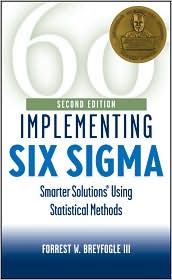What is Six Sigma System?
 Six sigma system is the specialized package of six sigma methodology, lean manufacturing programs and consulting services. Six sigma system rely on quality results of the products or services to meet the customer satisfaction, through better quality faster. The programs are set to meet the needs of the clients. The application of six sigma system depends on the business goals, opportunities and organizational landscape. It is on the basis of these three factors, six sigma system is designed and customized. Six sigma system always try to meet the industry standard through the practice of six sigma and lean manufacturing principals. According to six sigma system, the measurement of success is been measured on the client’s success and not on the number of clients or people trained, in six sigma system.
Six sigma system is the specialized package of six sigma methodology, lean manufacturing programs and consulting services. Six sigma system rely on quality results of the products or services to meet the customer satisfaction, through better quality faster. The programs are set to meet the needs of the clients. The application of six sigma system depends on the business goals, opportunities and organizational landscape. It is on the basis of these three factors, six sigma system is designed and customized. Six sigma system always try to meet the industry standard through the practice of six sigma and lean manufacturing principals. According to six sigma system, the measurement of success is been measured on the client’s success and not on the number of clients or people trained, in six sigma system.
The implementation of six sigma system is mainly done in the area of business process improvement. the establishment of Kanban systems by the six sigma system has reorganized product flow at various manufacturers.
Six Sigma Methodology:
The purpose and the origin of the process six sigma is the result of need for business improvement through customer satisfaction, reduced costs, production of high quality products with less defects and increased profits. Hence the fundamental aim of the six sigma methodology is the implementation of a systematically based measurement strategy focusing the improvement process. Within this improvement aspects the six sigma methodology includes the responsibilities of the improving the team, helping the team in identifying the process, the defects and the corresponding measurements. It is because of this wide range of flexibility in quality improvement, six sigma methodology toolkit is the best existing software process implementation.
Six sigma implements the quality improvement process through the application of six sigma improvement projects. These projects are accomplished with the help of the use of two six sigma sub-methodologies: DMAIC & DMADV.
DMAIC method: the six sigma methodology is consisted of five steps which includes Defining, Measuring, Analyzing, Improvement and Controlling. DMAIC involves in the improvement of an existing business process. Here the six sigma methodology deals with defining of the process improvement needed for setting the goals on the basis of customer demands and the enterprise strategy. Once the goal defining is done the project conductors are asked to measure the current strategy of the process or the work done and then to collect the data for the future comparisons. The third step is of analyzing the relationship between the cause (data) and with the result and defining it, making sure that all factors involved are taken into consideration. The fourth step follows the analysis report, by providing with sufficient improvements using the techniques like Design of Experiments. It should be ensured that all the variances are corrected before it result it defects. This is done through the controlling of the process, which is the final step in six sigma process of systematical improvement of the process.
DMAIC Six sigma leader roles are to establish the selection criteria of the project, approving the projects, selecting the project leaders, providing the resources and training, reviewing the Black Belt and Green Belt projects monthly, ensuring the communication process, reviewing the entire process every 3-6 months, establishing and linking the rewards with the performances, and finally being accountable for the success of the effort.
DMADV methods: as in the DMAIC method, here also it has 5 steps like defining, measuring, analyzing, designing and verifying. DMADV method is used in creating a new product or process, setting designs for predicting and then ensuring defect-free performances. The method deals with the duties like defining the goals, which comes out form the designed activity which is related to the customer demands and enterprise strategy. Once the goals is defined out of the activity, measuring and identifying the quality, product capabilities, production process capability and risk assessments are done.
The third step of the method involves in the analyzing process for developing the designing alternatives, creating high level design, evaluating designs and selecting the best design. Then comes the step, where detailing about the design selected, optimizing the design, and setting plans for the verification of the designs. This step is required simulations. At the final step the design set is verified and the pilots are run. There by the production process is implemented and the process is hand over to the process owners.
Apart from the above said six sigma methods there are other designs for six sigma methodologies. They are:
CDOC – conceptualize, design, optimize, control
DCCDI – define, customer concept, design and implement
DCDOV- define, concept, design, optimize, verify
D-IDOV-M – define, identify, design, optimize, verify, monitor
DMADOV – define, measure, analyze, design, optimize and verify
DMAI C – define, measure, analyze, improve, implement, control
DMEDI – define, measure, explore, develop and implement
IDOV – identify, design, optimize and validate
I2DOV – invent, innovate, develop, optimize, validate
MEDIC – map and measure, explore and evaluate, define and describe, implement and improve, control and conform
VCPCIA – visualize, commit, prioritize, characterize, improve, achieve
Lean Manufacturing Programs:
 The philosophy of lean manufacturing is derived from the “Toyota Production System”. Lean manufacturing is a generic process of management, for the production of goods through the removal of waste and implementing the flow. The operational strategy in lean manufacturing gives importance in the achievement of better production of goods that meet the customer’s satisfaction, through the process of shortest possible cycle time by eliminating waste and reducing incidental work. Lean manufacturing is a technique which helps in decreasing the time between the customer need and the shipment. It is designed in a way that there is a rapid improvement in the profit, gaining the customer satisfaction, reducing the production of time and sustaining the employee emotions. In general it is said that lean manufacturing is considered as a company’s “half human effort, the half manufacturing space, the half investment in tools and the half engineering hours for the development of a new product with in the half time scheduled”. It is clear that the benefits gained through the implementation of lean manufacturing is the lower costs, higher quality and shorter lead time for the production.
The philosophy of lean manufacturing is derived from the “Toyota Production System”. Lean manufacturing is a generic process of management, for the production of goods through the removal of waste and implementing the flow. The operational strategy in lean manufacturing gives importance in the achievement of better production of goods that meet the customer’s satisfaction, through the process of shortest possible cycle time by eliminating waste and reducing incidental work. Lean manufacturing is a technique which helps in decreasing the time between the customer need and the shipment. It is designed in a way that there is a rapid improvement in the profit, gaining the customer satisfaction, reducing the production of time and sustaining the employee emotions. In general it is said that lean manufacturing is considered as a company’s “half human effort, the half manufacturing space, the half investment in tools and the half engineering hours for the development of a new product with in the half time scheduled”. It is clear that the benefits gained through the implementation of lean manufacturing is the lower costs, higher quality and shorter lead time for the production.
The characteristics of lean processes are:
-Single-piece production
-Repetitive order characteristics
-Just-in-time materials or pull scheduling
-Short cycle times
-Quick changeover
-Continuous flow work cells
-Collocated machines, equipment, tools and people
-Compressed space
Lean manufacturing approaches:
 Lean manufacturing is used under two approaches. The first approach is used for the identification and the continuous elimination of the waste. It is clear that as the waste is being eliminated, the quality of the product improves, while the production time and cost is reduced. The second approach to lean manufacturing, is focusing on improving the “flow” of the work. By the word flow means, the smoothness of the work. in the second approach the focus is given in the smoothening of the work, through the system and not the waste reduction. The second approach was promoted by Toyota.
Lean manufacturing is used under two approaches. The first approach is used for the identification and the continuous elimination of the waste. It is clear that as the waste is being eliminated, the quality of the product improves, while the production time and cost is reduced. The second approach to lean manufacturing, is focusing on improving the “flow” of the work. By the word flow means, the smoothness of the work. in the second approach the focus is given in the smoothening of the work, through the system and not the waste reduction. The second approach was promoted by Toyota.
The difference between the two approaches lies not on the attainment of the goal, but achieving the goal at the first time itself. In the second approach, the smooth flow of the work helps in exposing the defects or the quality problems which is there in the work already. This exposing of the defects leads to the reduction of the waste naturally.
Consulting or Customer Service:
Six sigma system gives importance to customer service and customer satisfaction. The aim of six sigma system is to provide better quality products to make sure the customer satisfaction and services.
 A failure modes and effects analysis (FMEA) is a process of analysis of potential failure modes within a system. It is based on the determination of severity and the effect of failures on the system. It is widely used during the various phases of the product life cycle in manufacturing industries and is getting popular in the service industry.
A failure modes and effects analysis (FMEA) is a process of analysis of potential failure modes within a system. It is based on the determination of severity and the effect of failures on the system. It is widely used during the various phases of the product life cycle in manufacturing industries and is getting popular in the service industry. The success of a company depends on the strategic planning of the projects. Projects are the works assigned by a company, to meet the needs of the clients. For the successful implementation of the project, there should be a complete planning, adequate links between strategy and actions, and effective communication. Lacking of all these main factors, results in the poor performance of the production work and the customer’s dissatisfaction about the product. Six sigma accomplishes one project at a time. The stories of companies who have saved billions of dollars, have proved the effectiveness of the properly selecting and defining business issues. When the business issues are properly selected and defined, these issues can be assigned to Green Belts and Black Belts for solving it effectively. Six sigma projects are the perfect selection that a company or an organization can take to reach its strategic goals.
The success of a company depends on the strategic planning of the projects. Projects are the works assigned by a company, to meet the needs of the clients. For the successful implementation of the project, there should be a complete planning, adequate links between strategy and actions, and effective communication. Lacking of all these main factors, results in the poor performance of the production work and the customer’s dissatisfaction about the product. Six sigma accomplishes one project at a time. The stories of companies who have saved billions of dollars, have proved the effectiveness of the properly selecting and defining business issues. When the business issues are properly selected and defined, these issues can be assigned to Green Belts and Black Belts for solving it effectively. Six sigma projects are the perfect selection that a company or an organization can take to reach its strategic goals. Product or Service Design six sigma project ideas
Product or Service Design six sigma project ideas Six sigma metrics are the different types of measurements used in six sigma methodology, in order to measure the success of the company’s product quality. It doesn’t means, the simple collection and calculation of the data and defects are enough for the attainment of the success. In order to get the right measurement through the use of six sigma metrics, a successful business should apply these metrics in the right context in a innovative ways so as to solve the customer’s critics to the quality of the products. Therefore there are certain steps and six sigma metrics, in six sigma methodology to be applied for the defect-free products. six sigma calculator is the tool used for the measurement of the quality of the product in six sigma metrics. some of the areas in which the calculation is done are:
Six sigma metrics are the different types of measurements used in six sigma methodology, in order to measure the success of the company’s product quality. It doesn’t means, the simple collection and calculation of the data and defects are enough for the attainment of the success. In order to get the right measurement through the use of six sigma metrics, a successful business should apply these metrics in the right context in a innovative ways so as to solve the customer’s critics to the quality of the products. Therefore there are certain steps and six sigma metrics, in six sigma methodology to be applied for the defect-free products. six sigma calculator is the tool used for the measurement of the quality of the product in six sigma metrics. some of the areas in which the calculation is done are: Sigma Level Calculator:
Sigma Level Calculator: The process according to six sigma is the total number of sequences, series and the arrangements of events, steps or measurements done repeatedly for the production of quality products or services. Changing a process is the first step in a six sigma improvement program in order to reduce the costs and improve quality. There are different types of graphical representation for a process or procedure to show its flow type style of all actions and conclusion taking place in a process. There are process maps, flow charts, and SIPOC diagrams used for the graphical representation of the process.
The process according to six sigma is the total number of sequences, series and the arrangements of events, steps or measurements done repeatedly for the production of quality products or services. Changing a process is the first step in a six sigma improvement program in order to reduce the costs and improve quality. There are different types of graphical representation for a process or procedure to show its flow type style of all actions and conclusion taking place in a process. There are process maps, flow charts, and SIPOC diagrams used for the graphical representation of the process. The elements contained in a graphs are the starting point to the process and its sub-processes, an ending points to the process and its sub-processes, inputs, outputs and other types of direction and decisions which leads to another potential direction.
The elements contained in a graphs are the starting point to the process and its sub-processes, an ending points to the process and its sub-processes, inputs, outputs and other types of direction and decisions which leads to another potential direction. Six sigma system is the specialized package of six sigma methodology, lean manufacturing programs and consulting services. Six sigma system rely on quality results of the products or services to meet the customer satisfaction, through better quality faster. The programs are set to meet the needs of the clients. The application of six sigma system depends on the business goals, opportunities and organizational landscape. It is on the basis of these three factors, six sigma system is designed and customized. Six sigma system always try to meet the industry standard through the practice of six sigma and lean manufacturing principals. According to six sigma system, the measurement of success is been measured on the client’s success and not on the number of clients or people trained, in six sigma system.
Six sigma system is the specialized package of six sigma methodology, lean manufacturing programs and consulting services. Six sigma system rely on quality results of the products or services to meet the customer satisfaction, through better quality faster. The programs are set to meet the needs of the clients. The application of six sigma system depends on the business goals, opportunities and organizational landscape. It is on the basis of these three factors, six sigma system is designed and customized. Six sigma system always try to meet the industry standard through the practice of six sigma and lean manufacturing principals. According to six sigma system, the measurement of success is been measured on the client’s success and not on the number of clients or people trained, in six sigma system. The philosophy of lean manufacturing is derived from the “Toyota Production System”. Lean manufacturing is a generic process of management, for the production of goods through the removal of waste and implementing the flow. The operational strategy in lean manufacturing gives importance in the achievement of better production of goods that meet the customer’s satisfaction, through the process of shortest possible cycle time by eliminating waste and reducing incidental work. Lean manufacturing is a technique which helps in decreasing the time between the customer need and the shipment. It is designed in a way that there is a rapid improvement in the profit, gaining the customer satisfaction, reducing the production of time and sustaining the employee emotions. In general it is said that lean manufacturing is considered as a company’s “half human effort, the half manufacturing space, the half investment in tools and the half engineering hours for the development of a new product with in the half time scheduled”. It is clear that the benefits gained through the implementation of lean manufacturing is the lower costs, higher quality and shorter lead time for the production.
The philosophy of lean manufacturing is derived from the “Toyota Production System”. Lean manufacturing is a generic process of management, for the production of goods through the removal of waste and implementing the flow. The operational strategy in lean manufacturing gives importance in the achievement of better production of goods that meet the customer’s satisfaction, through the process of shortest possible cycle time by eliminating waste and reducing incidental work. Lean manufacturing is a technique which helps in decreasing the time between the customer need and the shipment. It is designed in a way that there is a rapid improvement in the profit, gaining the customer satisfaction, reducing the production of time and sustaining the employee emotions. In general it is said that lean manufacturing is considered as a company’s “half human effort, the half manufacturing space, the half investment in tools and the half engineering hours for the development of a new product with in the half time scheduled”. It is clear that the benefits gained through the implementation of lean manufacturing is the lower costs, higher quality and shorter lead time for the production. Lean manufacturing is used under two approaches. The first approach is used for the identification and the continuous elimination of the waste. It is clear that as the waste is being eliminated, the quality of the product improves, while the production time and cost is reduced. The second approach to lean manufacturing, is focusing on improving the “flow” of the work. By the word flow means, the smoothness of the work. in the second approach the focus is given in the smoothening of the work, through the system and not the waste reduction. The second approach was promoted by Toyota.
Lean manufacturing is used under two approaches. The first approach is used for the identification and the continuous elimination of the waste. It is clear that as the waste is being eliminated, the quality of the product improves, while the production time and cost is reduced. The second approach to lean manufacturing, is focusing on improving the “flow” of the work. By the word flow means, the smoothness of the work. in the second approach the focus is given in the smoothening of the work, through the system and not the waste reduction. The second approach was promoted by Toyota. Six sigma tools are the techniques and approaches used by six sigma methodology, in the every day development process, of an organization. Implementation of these tools in a justified manner, lead to an amazing result. This investment tools and techniques act as a good place to start a new process. There are several tools and techniques to be used, but it has to be used in an appropriate way to get the better quality results. The brief description of some of the major tools and techniques are as follows.
Six sigma tools are the techniques and approaches used by six sigma methodology, in the every day development process, of an organization. Implementation of these tools in a justified manner, lead to an amazing result. This investment tools and techniques act as a good place to start a new process. There are several tools and techniques to be used, but it has to be used in an appropriate way to get the better quality results. The brief description of some of the major tools and techniques are as follows. PRIORITIZE REQUIREMENTS: When a new project is done it is important to categorize the requirements according to its importance. Commonly people act as if it is not necessary to do this at the bottom level and gives importance in doing everything. Until the delivery date, prioritizing the requirements are not done, and then the importance will be given to the product to be released instead of the requirements needed for the production of the products. The use age of six sigma tools will help in prioritizing the requirements from simple to the analytical hierarchy process. This ensures the quality functional deployment.
PRIORITIZE REQUIREMENTS: When a new project is done it is important to categorize the requirements according to its importance. Commonly people act as if it is not necessary to do this at the bottom level and gives importance in doing everything. Until the delivery date, prioritizing the requirements are not done, and then the importance will be given to the product to be released instead of the requirements needed for the production of the products. The use age of six sigma tools will help in prioritizing the requirements from simple to the analytical hierarchy process. This ensures the quality functional deployment. PROCESS CAPABILITY EVALUATION (Cp): The performance measures of the projects must be tracked and measured as a part of control plan. Data like online response times, reliability numbers, restore cycle times etc can be used as the process capability numbers to validate these measurements.
PROCESS CAPABILITY EVALUATION (Cp): The performance measures of the projects must be tracked and measured as a part of control plan. Data like online response times, reliability numbers, restore cycle times etc can be used as the process capability numbers to validate these measurements. 1) Six sigma methodology
1) Six sigma methodology